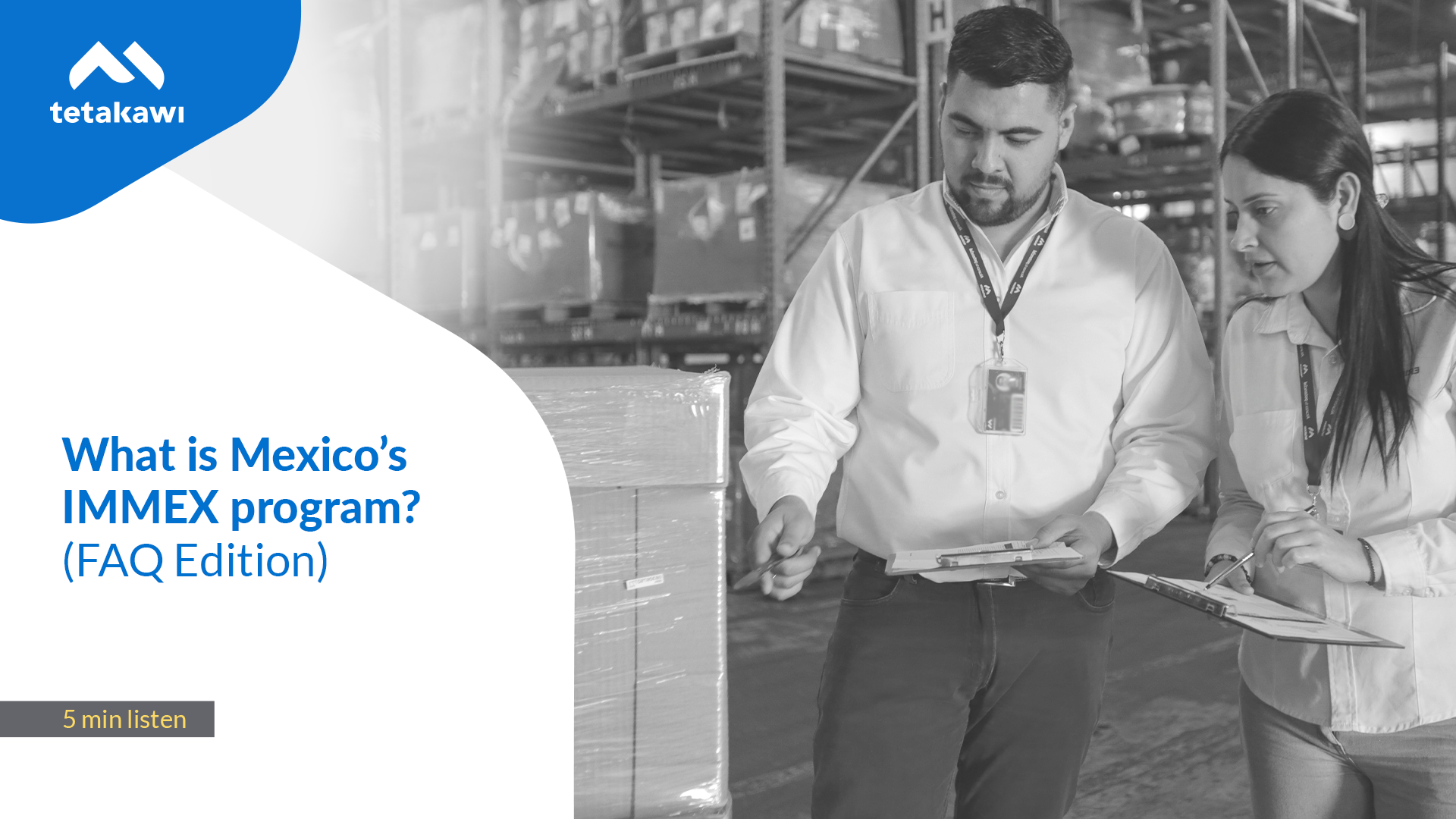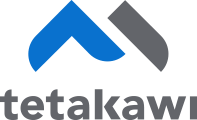
Episode 12: Podcast: What Is Mexico’s IMMEX Program?
In this episode of Tetakawi’s Manufacturing in Mexico Podcast – FAQ Edition, we unpack one of the most frequently askek, but critically misunderstood, topics in Mexico manufacturing strategy: What is the IMMEX Program, and why does it matter?
In just under five minutes, this short-format episode offers a clear, executive-level overview of the Maquiladora and Export Services Industry Program (IMMEX), Mexico’s cornerstone duty deferral framework for manufacturers producing for export.
Key Highlights
IMMEX Defined
IMMEX enables companies to temporarily import most raw materials, components, and capital goods into Mexico without paying general import duties, so long as the finished goods are exported within a designated timeframe.
Strategic Advantage
IMMEX provides a powerful cost advantage, but only when paired with the right structure. Companies must obtain IVA certification to defer Mexico’s 16% Value Added Tax (IVA) and avoid tying up cash flow at the border.
IVA Certification & Annex 31
Annex 31 is the mechanism that enables VAT recovery. Without this certification, companies may face delayed refunds or be required to post a financial guarantee.
Capital Equipment Planning
To avoid permanent duties on machinery that stays in Mexico, companies often require additional programs like PROSEC or Regla Octava (Rule 8).
Compliance Requirements
Companies under IMMEX must meet export thresholds, maintain real-time inventory tracking (Annex 24), and reconcile with Mexico’s tax authority (SAT) monthly via Annex 31.
Industrial vs. Shelter Pathways
The industrial modality of IMMEX requires forming a Mexican entity and can take 8–12 months to activate. The shelter modality, by contrast, allows companies to launch in a matter of weeks under the umbrella of an experienced partner like Tetakawi.
Closing Thoughts
IMMEX is more than a tax exemption, it’s a strategic lever that impacts cash flow, compliance, and speed to market. But it’s not turnkey. Without IVA certification, Annex infrastructure, and export alignment, companies risk delays and penalties.
At Tetakawi, our Manufacturing Campus model includes ready-to-use IMMEX and IVA certification, along with the systems and teams required to stay compliant.
Stay tuned for more FAQ Edition episodes of our Manufacturing in Mexico Podcast, where we break down what manufacturing executives need to know to scale confidently into Mexico.
Links
Visit our blog to learn more
Episode Transcript
[speaker1]
Welcome to Tetakawi’s Manufacturing in Mexico Podcast — FAQ Edition.
[speaker2]
Hello! This is a show where we help manufacturing executives like you understand what it really takes to launch, operate, and thrive in Mexico.
[speaker1]
So today we’re answering a question that’s come up in nearly every executive strategy session we’ve been a part of: what exactly is IMMEX?
[speaker2]
IMMEX is an acronym that roughly translates to the Maquiladora and Export Services Industry Program. It’s the backbone of Mexico’s legal framework for duty deferral in export manufacturing—and if you’re evaluating Mexico as a production site, it’s a program you need to understand.
[speaker1]
At a high level, IMMEX allows companies to temporarily import most raw materials, components, and some equipment into Mexico without paying general import duties—provided those goods are transformed and exported within a set timeframe.
[speaker1]
Typically, you have up to 18 months to export those goods—longer for certain containers or tooling. But here's the nuance: while IMMEX defers duties, it does not automatically defer Mexico’s 16% Value Added Tax, or IVA.
[speaker2]
To avoid paying IVA at the time of import, you need to obtain an IVA certification once you have your IMMEX in place. That’s what allows you to recover the tax up front—through a mechanism called Annex 31.
[speaker1]
Without that certification? You’re either paying the IVA and waiting for a refund—or, posting a financial guarantee. And for high-volume importers, that can tie up millions in working capital.
[speaker2]
Let’s talk equipment. Yes—capital goods like machinery can be temporarily imported under IMMEX. But if they’re not exported later, they must be regularized through additional programs—like PROSEC or Regla Octava (Rule 8)—to avoid permanent duties.
[speaker1]
Exactly. It’s a common oversight. IMMEX isn’t a blanket exemption—it’s a duty deferral mechanism with strict eligibility criteria, especially by HS code. And permanent equipment strategies require their own strategic planning.
[speaker1]
Now, compliance is where this program becomes operationally intense. First, IMMEX holders must export at least 80% of what they import temporarily. And, they must generate either $500,000 USD or 10% of total sales in exports annually.
[speaker2]
There’s also the real-time inventory reconciliation. That’s done through two systems—Annex 24 for inventory tracking, and Annex 31 for matching imports and exports to tax authority records. That’s all audited by SAT—Mexico’s IRS equivalent.
[speaker1]
So how do companies access IMMEX? For export manufacturers, there are two primary modalities: IMMEX industrial and the IMMEX shelter.
[speaker2]
With the industrial modality of IMMEX, you form your own Mexican legal entity, apply for IMMEX, set up VAT certification, and build your own compliance systems and teams. That process can, uh, typically take 8 to 12 months before you're fully operational.
[speaker2]
The shelter modality is different. Providers like Tetakawi already hold an IMMEX decree and the ancillary certifications. That means you can launch production in a matter of weeks while offloading compliance and reporting to the shelter team.
[speaker1]
You still control your line, your quality, your IP. But the shelter manages the complexity—IMMEX registration, VAT certification, Annex reporting, audits. It transforms a regulatory maze into a manageable system.
[speaker2]
So here’s the executive takeaway: IMMEX isn’t just a tax mechanism. It’s a strategic lever. Done right, it accelerates speed to market, reduces landed cost, and minimizes compliance risk.
[speaker1]
But get it wrong—or underestimate its complexity—and it becomes a liability. So here are the key questions to ask as you move forward:
[speaker1]
Are your inputs IMMEX-eligible by HS code?
Will you need PROSEC or Regla Octava for equipment?
Can you realistically secure VAT certification?
Who’s managing your Annex 24 and 31 systems?
And can you consistently meet the 80% export threshold?
[speaker2]
And finally—based on your goals, timeline, and internal resources—is the industrial modality right for you? Or is shelter the better fit?
[speaker1]
Thanks for joining us on Tetakawi’s Manufacturing in Mexico Podcast — FAQ Edition.
[speaker2]
We’ll see you next time!

